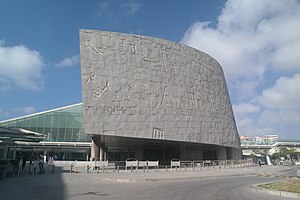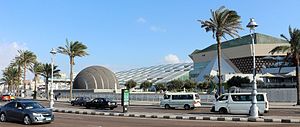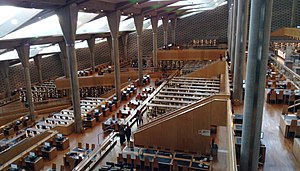Bibliotheca Alexandrina
| Library of Alexandria | |
|---|---|
| مكتبة الإسكندرية Bibliotheca Alexandrina | |
 | |
 | |
| 31°12′32″N 29°54′33″E / 31.20889°N 29.90917°E | |
| Location | Alexandria, Egypt |
| Type | National library |
| Established | 16 October 2002 |
| Access and use | |
| Members | 16,322 (2012) |
| Other information | |
| Director | Ahmed Abdullah Zayed |
| Website | www |


The Bibliotheca Alexandrina (Latin, 'Library of Alexandria';[1] Arabic: مكتبة الإسكندرية, romanized: Maktabat al-’Iskandariyya, Egyptian Arabic pronunciation: [mækˈtæb(e)t eskendeˈɾejjæ]) (BA) is a major library and cultural center on the shore of the Mediterranean Sea in Alexandria, Egypt. It is a commemoration of the Library of Alexandria, once one of the largest libraries worldwide, which was lost in antiquity. The Bibliotheca Alexandrina contains books in classical Arabic, English, and French languages.
The idea of reviving the old library dates back to 1974 when a committee set up by Alexandria University selected a plot of land for its new library. Construction work began in 1995, and after some US$220 million had been spent, the complex was officially inaugurated on 16 October 2002. In 2009, the library received a donation of 500,000 books from the Bibliothèque nationale de France (BnF). The gift makes the Bibliotheca Alexandrina the sixth-largest Francophone library in the world.[2]
The library offers shelf space for eight million books, and its main reading room spans 20,000 square meters (220,000 sq ft). The complex also houses a conference center; specialized libraries for maps, multimedia, the blind and visually impaired, and for children; four museums; four art galleries four temporary exhibitions; 15 permanent exhibitions; a planetarium; and a manuscript restoration laboratory.
History
[edit]

The idea of reviving the Library of Alexandria dates back to 1974, when a committee set up by Alexandria University selected a plot of land for its new library between the campus and the seafront, close to where the ancient library once stood. One leading supporter of the project was former Egyptian President Hosni Mubarak, along with a partnership with UNESCO.
UNESCO organized an architectural design competition in 1988 to choose the design. The competition was won by Snøhetta, a Norwegian architectural office, among 524 other entries.[3] UNESCO also created an International Commission for the Bibliotheca Alexandrina.[4][non-primary source needed] The first pledges were made for funding the project at a conference held in 1990 in Aswan along the upper Nile River with US$65 million, mostly from the MENA states. Construction work began in 1995, and, after some additional US$220 million had been spent, the complex was officially inaugurated on 16 October 2002.[5][6][7]
The Internet Archive donated US$5 million to the BA, including 10 billion web pages from over 16 million sites, 2000 hours of Egyptian and U.S. television broadcasts, 1000 archival films, 100 terabytes of data stored on 200 computers, and a bookscanning facility for local books.[8] The library also received a supplementary donation of 500,000 books from the Bibliothèque nationale de France in Paris.
Features
[edit]The library has shelf space for eight million books,[9] with the main reading room covering 20,000 square metres (220,000 sq ft) on eleven cascading levels. The complex also houses a conference center; specialized libraries for maps, multimedia, the blind and visually impaired, young people, and for children; four museums;[9] four art galleries for temporary exhibitions; 15 permanent exhibitions; a planetarium;[9] and a manuscript restoration laboratory.
The main reading room stands beneath a 32-meter-high glass-panelled roof, tilted out toward the sea like a sundial, and measuring some 160 m in diameter. The walls are of gray granite, carved with characters from 120 scripts.[9]
Services
[edit]The main library can hold up to eight million books.[10] The library provides access to print on demand books via the Espresso Book Machine.[11]
The Taha Hussein Library contains materials for the blind and visually impaired using special software that makes it possible for readers to read books and journals. It is named after Taha Hussein, the Egyptian professor of Arabic and literary critic who was himself blinded at the age of three.[12]
Contains book collections of Nobel Prize Laureates in Literature from 1901.[13] The Nobel Section was inaugurated by Queen Silvia of Sweden and Queen Sonja of Norway on 24 April 2002.[14]
Museums
[edit]Antiquities Museum
[edit]Established in 2001, the Antiquities Museum is an archeological museum that was situated within a library.[15] It held approximately 1,316 artifacts. The collection includes underwater antiquities from the Mediterranean seabed near the Eastern Harbour and the Bay of Abukir.[16] The museum provides descriptions of artifacts in three languages: English, Arabic, and French.
Manuscript Museum
[edit]The Manuscript Museum provides visitors and researchers with rare manuscripts and books. Established in 2001, the Manuscript Museum contains the world's largest collection of digital manuscripts.[17] The Manuscript Museum operates alongside the Manuscript Center.
Sadat Museum
[edit]This museum contains many personal belongings of the Egyptian president, Anwar Al Sadat. The collections include some of his military robes, his Nobel Prize medal, his copy of the Qur'an, a few of his handwritten letters, pictures of him and his family, and the blood-stained military robe he wore on the day of his assassination. The museum also contains a recording in his voice of part of the Qur'an and assorted newspaper articles written about him.[18]
Permanent exhibitions
[edit]The Our Digital World exhibition displays some of the library's digital projects, including digital archives of former presidents, the Science Supercourse, and the Encyclopedia of Life.[19] Additionally, digital versions of books, such as Description de l'Egypte and L'Art Arabe, are available.
The World of Shadi Abdel Salam exhibition contains works of Egyptian film director and screenwriter Shadi Abdel Salam. The work was donated by his family.[20] The Impressions of Alexandria exhibition is divided into two sections: Alexandria as seen by Artists and Travelers and Cosmopolitan Alexandria: a Photographic Memory.[20]
The Culturama is a hall that consists of a 180-degree panoramic interactive computer screen with a diameter of 10 meters that is made up of nine separate flat screens arranged in a semicircle and nine video projectors controlled by a single computer.[21] It was developed by the Egyptian Center for Documentation of Cultural and CULTNAT and holds its patent in 2007.

Digital Assets Repository
[edit]The Digital Assets Repository (DAR) is a system developed at the Bibliotheca Alexandrina by the International School of Information Science (ISIS) that maintains a digital library collections[22] as well as providing free public access to the library's digitized collections through web-based search and browsing facilities[22][23] via DAR's website.[24]
Management
[edit]Per Presidential Decree No. 76 in 2001, the Bibliotheca Alexandria is managed by a Council of Patrons, a Board of Trustees, and a Director.[25] The founding director was Ismail Serageldin, who served until May 2017. He was succeeded by manager Moustafa El Feqy.[26][27]
The Board of Trustees shall number no less than fifteen and no more than thirty, of whom five shall be ex-officio members of the Egyptian Government, namely the Minister of Higher Education and Scientific Research, the Minister of Culture, the Minister of Foreign Affairs, the Governor of Alexandria and the President of the University of Alexandria.[28]
Post-revolutionary involvement
[edit]While the library was shut down during the 2011 Egyptian revolution, young adults were seen in a circle around the building to protect against looters and vandals.[29] Students from neighboring universities make up 80% of Bibliotheca Alexandrina patrons. The Bibliotheca Alexandrina held a variety of symposiums in 2011, emphasizing the 2011 Egyptian revolution. Other topics included in these symposiums were social work. All of these events were freely available to the public.[30]
Criticism
[edit]Many alleged that the library is a white elephant, which serves little more than a vanity project for the Egyptian government. Furthermore, there are fears that censorship would affect the library's collection.[31]
The building's architecture (which imitates a rising Sun) upset some who believed too much money was being spent on construction rather than the library's actual collection. Due to the lack of available funds, the library had only 500,000 books in 2002; however, in 2010, the library received an additional 500,000 books from the Bibliothèque nationale de France. The library relies on donations to buy books for its collections.[32]
See also
[edit]References
[edit]- ^ Richard, Pamela Spence; Wiegand, Wayne A.; Dalbello, Marija (26 May 2015). A History of Modern Librarianship: Constructing the Heritage of Western Cultures. Libraries Unlimited. p. 170. ISBN 978-1610690997. Retrieved 3 July 2020.
- ^ "Top 100 Largest Libraries In The World – P35. Bibliotheca Alexandrina – Alexandra, Egypt". WCSA World. 12 July 2017. Archived from the original on 3 January 2019. Retrieved 12 October 2022.
- ^ "Bibliotheca Alexandrina".
- ^ Tocatlian, J. (2003). "Bibliotheca Alexandrina: From Dream to Reality". The International Information & Library Review. 35 (1): 39–50. doi:10.1080/10572317.2003.10762592. S2CID 220313364.
- ^ Alexandrina
- ^ Clare Davies. "Archive Map: Egypt" (PDF). Speak Memory. Archived from the original (PDF) on 6 October 2014. Retrieved 5 October 2014.
- ^ "Bibliotheca Alexandrina to be Officially Inaugurated on 16 October | United Nations Educational, Scientific and Cultural Organization". UNESCO. Retrieved 14 October 2020.
- ^ "Bibliotheca Alexandrina". Internet Archive. Archived from the original on 2 September 2014. Retrieved 28 October 2014.
- ^ a b c d Planet, Lonely. "Bibliotheca Alexandrina – Lonely Planet". Lonely Planet. Archived from the original on 20 March 2016. Retrieved 18 May 2016.
- ^ "Bibliotheca Alexandrina Overview". Bibliotheca Alexandrina. Retrieved 16 October 2016.
- ^ "EBM Locations: List View". OnDemandBooks.com. Archived from the original on 22 April 2012. Retrieved 14 May 2012.
- ^ "Taha Hussein Library". Bibalex.org. Retrieved 11 February 2021.
- ^ "Nobel Section". Bibliotheca Alexandrina. Retrieved 22 July 2017.
- ^ Herkovic, Andrew (15 December 2010). "The New Alexandrian Library". Electrum Magazine.
- ^ "Overview – Antiquities Museum". Bibliotheca Alexandrina. Archived from the original on 17 August 2010. Retrieved 13 October 2014.
- ^ "Antiquities Museum – Museums – Bibliotheca Alexandrina". Bibliotheca Alexandrina. Archived from the original on 6 May 2010. Retrieved 13 October 2014.
- ^ "Manuscript Museum – Museums". Bibliotheca Alexandrina. Archived from the original on 6 May 2010. Retrieved 21 October 2014.
- ^ "Sadat Museum". Bibalex.org. Retrieved 11 February 2021.
- ^ "From Printed to Digital – Permanent Exhibitions". Bibliotheca Alexandrina. Archived from the original on 9 August 2014. Retrieved 29 September 2014.
- ^ a b "Personal Collections – Permanent Exhibitions". Bibliotheca Alexandrina. Archived from the original on 6 May 2010. Retrieved 29 September 2014.
- ^ CULTNAT Celebrated CULTURAMA Patent in the Smart Village Archived 12 March 2012 at the Wayback Machine United Nations. 11 July 2008. Retrieved 5 October 2014.
- ^ a b George M. Eberhart (2013). The Whole Library Handbook 5: Current Data, Professional Advice, and Curiosa. American Library Association. p. 59. ISBN 978-0-8389-1090-0. Archived from the original on 12 December 2016.
- ^ Ravindra N. Sharma; IFLA Headquarters (30 July 2012). Libraries in the early 21st century, volume 2: An international perspective. Walter de Gruyter. pp. 213–214. ISBN 978-3-11-029285-5. Archived from the original on 12 March 2017.
- ^ "Digital Assets Repository (DAR) Official website". Digital Assets Repository. Bibliotheca Alexandrina. Archived from the original on 7 May 2007. Retrieved 31 January 2015.
- ^ "Bibliotheca Alexandria About Us page". Bibliotheca Alexandria's website. Retrieved 12 June 2022.
- ^ "Dr. Mostafa el Feki Appointed as BA Director". Bibalex.org. Retrieved 2 September 2018.
- ^ "Professor and former diplomat Mostafa El-Feki appointed head of Bibliotheca Alexandrina – Politics – Egypt – Ahram Online". english.ahram.org.eg. Retrieved 2 September 2018.
- ^ "Presidential Decree No. 76 for the Year 2001 – Bibliotheca Alexandrina". www.bibalex.org. Retrieved 12 June 2022.
- ^ Simmons-Duffin, Selena (24 February 2011). "Egypt's Jewel Of A Library Reopens, Thanks To Demonstrators". NPR.
- ^ El-Ramady, Amany Zakaria (June 2011). "A Case Study of Bibliotheca Alexandrina in Supporting the Egyptian Revolution". International Leads. 25 (2): 3, 5. ProQuest 898792560.
- ^ Bilboul, Roger (December 2002), "The Library of Alexandria Reopens", Information Today, 19 (11): 26, archived from the original on 30 September 2007
- ^ Watson, Bruce (April 2002), "Rising Sun", Smithsonian, archived from the original on 19 April 2013
Further reading
[edit]- Watson, Bruce (April 2002). "Rising Sun". Smithsonian Magazine. Archived from the original on 19 April 2013. Retrieved 24 February 2009.
- Ali, Amro (16 October 2012) "Power, Rebirth and Scandal: A Decade of the Bibliotheca Alexandrina". Jadaliyya.
External links
[edit]- Official website

- https://www.facebook.com/bibalexOfficial
- https://twitter.com/bibalexOfficial
- https://www.instagram.com/bibalexofficial/
- https://www.youtube.com/user/BAchannel
- Bibliotheca Alexandrina Webcast
- Bibliotheca Alexandrina webarchive
- Wikimania 2008 venue description
- About Bibliotheca Alexandrina
- Bibliotheca Alexandrina
- Library buildings completed in 2002
- World Digital Library partners
- Scientific Revolution
- Ancient Alexandria in art and culture
- 21st-century architecture in Egypt
- Culture in Alexandria
- Education in Alexandria
- Modernist architecture
- Expressionist architecture
- Libraries in Egypt
- Cultural centers in Africa
- Museums in Egypt
- Buildings and structures in Alexandria
- Tourist attractions in Alexandria
- 2002 establishments in Egypt
- Rebuilt buildings and structures
- Libraries established in 2002
- Organisations based in Alexandria
- Government agencies of Egypt
